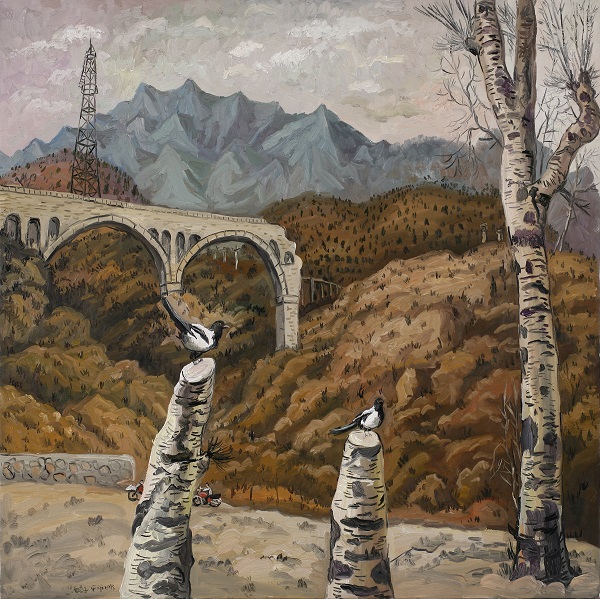
Xu Zhen, The struggle of man against power is the struggle of memory against forgetting (2010).
Photo: Courtesy of MadeIn Company.
“I’m not doing a definitive survey of the development of contemporary Chinese art, but I wanted to do two things,” Philip Tinari, director of the Ullens Center for Contemporary Art in Beijing and curator of the Armory Show’s Focus: China section, told artnet News recently. “Give a sense of the exciting new generation that’s just coming of age; and then also to contextualize them in maybe lesser-known moments that relate to the 35-year story of contemporary art in China.”
Tinari’s China section, appropriately, will be very eclectic, with a number of regulars on the international art fair circuit exhibiting alongside Armory Show first-timers. This marks the fifth outing of the New York fair’s geographically determined Focus section, following presentations devoted to galleries from Berlin in 2010, Latin America in 2011, Nordic and Scandinavian countries in 2012, and the US in 2013. As in those instances, the format raises questions about the relevance of regionalism in the thoroughly international contemporary art community.
“It goes back to this question about ‘What is Chinese or not about Chinese contemporary art?’,” Tinari said. “With an earlier generation, in the mainstream telling, it often comes down to very discernible symbols and elements and content matter. With this younger generation, which is just so much more naturally conversant with everything that’s going on in the world—not only because of China’s enhanced position in it but also because of the massive shrinking of time and space that has happened as the internet made its way into all of our minds and hearts—you get a way of art-making that is much less recognizably Chinese but that’s still very deeply informed by concerns and subjectivities that are forged on the ground.”
Qin Qi, Bearer of good news (2013).
Photo: Courtesy of the artist and Platform China.
The symbolic and literal centerpiece of Focus: China will be a performance-activated installation by this year’s commissioned artist, Xu Zhen, Action of Consciousness, which will occupy the center of the section with the gallery booths arrayed around it. Though Xu is best known for his large-scale, hyper-realistic installations and monumental sculptures, his major work for the Armory Show will have a much subtler and more playful presence.
“Action of Consciousness involves what looks like a booth built out from four walls, your archetypal white cube, and from time to time sculptures will appear over the upper edges of the cube, which turn out to be thrown up into the air by people who are essentially trapped inside it,” Tinari explained. “They are made of very straightforward juxtapositions of symbolic elements, like a Roman column with a Chinese lantern on top of it—basically works that only need a few seconds to be understood and interpreted. I think it’s a commentary on a lot of things, but one of them is what it means to make snap judgments about a work of art, which people are doing all the time in a fair setting, and how that happens, and what’s behind all that—in this case, invisible human labor that’s making these signs suddenly appear and then disappear.”
For Tinari, Xu serves as an intergenerational figure representative of the entire Focus: China section, which is more or less divided between artists who have come of age in the 2000s, and those who rose to prominence in the ’80s and ’90s—with the conspicuous absence of the most famous artist, Ai Weiwei.
“As much as I love and have written extensively about Ai Weiwei, there actually are other artists in China besides him,” Tinari said. “This should be an attempt to get a somewhat holistic picture, or what we might imagine as holistic, of the ecology, the system in all of its depth and diversity, and the major trends.”
Liang Shuo, Fit No.8 (2014).
Photo: Courtesy of Gallery Yang, Beijing.
Tinari sought to highlight lesser-known young artists—like the Double Fly Art Center collective, showing in Beijing gallery Space Station’s booth, and He Xiangyu in White Space’s booth—as well as rarely-seen works by more established figures, like Huang Rui, who will be showing a cycle of abstract paintings from the 1983-85 that have never been seen before in 10 Chancery Lane’s booth. In doing so, he will showcase a number of galleries that will be new to Western audiences.
“You have a few Chinese galleries that are regulars at the Friezes and at the Basels, but for every one of those there are five who are just almost at that level and who apply every year, and who go through that same experience of getting rejected from the college of their choice over and over again,” Tinari said. “And that’s because the big international fairs only have so much bandwidth for Asia, even today.”
By trying to complicate common Western perceptions of Chinese contemporary art—through a less homogenous set of exhibitors, a lineup of artists from different generations, and by shedding light on unfamiliar works by familiar artists—Tinari would like visitors to the Focus: China section will come away with a richer and more nuanced sense of the scene.
“I hope that this presentation can counter this idea that China is defined by a suspicious auction market and government repression and censorship,” he said. “Yes, maybe both of those things happen, but in addition to that you actually have the makings of a very organic and healthy scene on the ground. And it’s not everybody who has a chance to come to Beijing and Shanghai and do the galleries, and dive into the scene for a couple of days, so hopefully by spending a little bit of time in the section the interested viewer might be able to get a sense of what it feels like over here.”
Xu Zhen, Play (2013).
Photo: Courtesy of MadeIn Company.